


A year into the pandemic that has upended life as we know it, there are still several missing pieces to the COVID-19 puzzle. A research team led by Sonia Villapol, PhD, assistant professor of neurosurgery at the Center for Neuroregeneration at Houston Methodist, is diligently working to locate one of these pieces − understanding the phenomenon of ‘long COVID’ or Post-Acute Sequelae of SARS-CoV-2 infection (PASC), a constellation of lingering symptoms that range from mild to debilitating.
A recent systematic review and meta-analysis of the long-term effects of COVID-19 posted on the preprint server medRxiv led by Villapol shows that among 47,910 patients included in the analysis, 80 percent report persistent symptoms lasting weeks to months following acute infection. Of the 55 identified effects, the most common long COVID symptoms were fatigue (58%), headache (44%), attention disorder (27%), hair loss (25%) and dyspnea (24%). The paper is current ranked among the top 5% of all research outputs scored by Altmetric.

By identifying and quantifying the prevalence of long-term effects of COVID-19, our study confirms that the burden of long COVID is substantial. Prompt assessment and intervention is critical for halting the progression of and minimizing the effect of these medical complications.
Sonia Villapol, PhD
Assistant Professor of Neurosurgery
The next step in their research will focus on determining what makes some individuals more susceptible to long COVID. Villapol believes that gut microbes may have a key role to play.
The meta-analysis reported that 80% of the patients with COVID-19 have long-term symptoms. Abbreviations: C-reactive protein (CRP), computed tomography (CT), Interleukin-6 (IL-6), N-terminal (NT)-pro hormone BNP (NT-proBNP), Obsessive Compulsive Disorder (OCD), Post-traumatic stress disorder (PTSD).
The intestinal tract is the largest immune organ in the body and houses millions of microbes that are critical for modulating immune response. “We know that the elderly as well as people with certain underlying medical conditions such as heart disease, diabetes and asthma, exhibit reduced microbial diversity. Interestingly, this population is also more likely to develop severe complications due to systemic inflammation from COVID-19,” explained Villapol. Although the correlation between gut microbiome make-up and COVID-19 severity was established previously, Villapol’s team plans to validate, extend and build upon this link. Their hypothesis is that, in addition to influencing prognosis, changes in gut microbiota might trigger prolonged inflammatory responses in patients with long COVID.
Although COVID-19 is primarily a respiratory disease, during early stages of infection many patients experience gastrointestinal symptoms such as nausea, vomiting or diarrhea. Such gastrointestinal changes create an imbalance in gut microflora that can cause the release of proinflammatory cytokines. Villapol’s team will analyze the changes in gut microbiota in patients who tested positive for SARS-CoV-2. Saliva and stool samples will be collected when they test positive and after 2 weeks and 6 months. By providing a snapshot of how the gut microflora changes over time, this research could shed some light on possible association between gut dysbiosis and long COVID. Once the gut microflora changes are characterized, therapeutic approaches with pre or probiotics could be used to correct the microbiome imbalance and help mitigate the effects of long COVID.
Lopez-Leon, S, Wegman-Ostrosky, T, Perelman, C, Sepulveda, R, Rebolledo, PA, Cuapio, A, Villapol, S. More than 50 Long-term effects of COVID-19: a systematic review and meta-analysis. medRxiv January 30, 2021; Preprint DOI: https://doi.org/10.1101/2021.01.27.21250617
This work was supported by funding from the Houston Methodist Research Institute and with federal grant funds from the National Institute for Neurological Disorders and Stroke, National Institutes of Health, Department of Health and Human Services, R21NS106640.
By Maitreyi Muralidhar, April 2021
Related Articles









